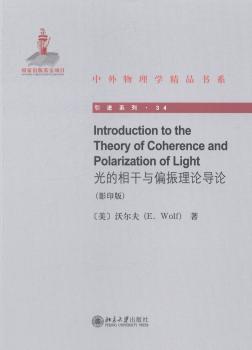内容简介
所有的光场都是随机涨落的,有些光场的随机涨落很小,例如许多激光器输出的光;有些光场的随机涨落相当大,例如从热光源辐射的光。描述涨落光场的基础理论是相干理论。部分偏振现象就是涨落的重要表现。实际上,相干理论所能处理的问题不于涨落。与常规的处理方法不同,相干理论是依据可观测量描述光场,并解释这些可观测量,例如光的光谱以及它在传输中如何变化的。
《光的相干与偏振理论导论(英文影印版)》给出了光的相干与偏振现象的统一处理方法。适合光通信、激光光束在光纤中和通过湍流大气传输、光学成像,尤其在显微镜成像(例如医学诊断)的物理界和工程界的研究者阅读。
目录
Preface page xi
1. Elementary coherence phenomena 1
1.1 Interference and statistical similarity 1
1.2 Temporal coherence and the coherence time 4
1.3 Spatial coherence and the coherence area 5
1.4 The coherence volume 8
Problems 10
2. Mathematical preliminaries 11
2.1 Elementary concepts of the theory of random processes 11
2.2 Ergodicity 17
2.3 Complex representation of a real signal and the envelope
of a narrow-band signal 19
2.4 The autocorrelation and the cross-correlation functions 22
2.4.1 The autocorrelation function of a finite sum of periodic
components with random amplitudes 24
2.5 The spectral density and the Wiener-Khintchine theorem 25
Problems 29
3. Second-order coherence phenomena in the space-time domain 31
3.1 Interference law for stationary optical fields. The mutual
coherence function and the complex degree of coherence 31
3.2 Generation of spatial coherence from an incoherent source.
The van Cittert-Zernike theorem 37
3.3 Illustrative examples 46
3.3.1 Michelson's method for measuring stellar diameters 46
3.3.2 Michelson's method for determining energy distribution
in spectral lines 51
3.4 Propagation of the mutual intensity 54
3.5 Wave equations for the propagation of mutual coherence in free space 56
Problems 58
4. Second-order coherence phenomena in the space-frequency domain 60
4.1 Coherent-mode representation and the cross-spectral density
as a correlation function 60
4.2 The spectral interference law and the spectral degree of coherence 63
4.3 An illustrative example: spectral changes on interference 69
4.4 Interference of narrow-band light 73
Problems 76
5. Radiation from sources of different states of coherence 79
5.1 Fields generated by sources with different coherence properties 79
5.2 Correlations and the spectral density in the far field 81
5.3 Radiation from some model sources 88
5.3.1 Schell-model sources 88
5.3.2 Quasi-homogeneous sources 90
5.4 Sources of different states of spatial coherence which generate
identical distributions of the radiant intensity 95
5.5 Coherence properties of Lambertian sources 97
5.6 Spectral changes on propagation. The scaling law 102
Problems 108
6. Coherence effects in scattering 111
6.1 Scattering of a monochromatic plane wave on a deterministic medium 111
6.2 Scattering of partially coherent waves on a deterministic medium 115
6.3 Scattering on random media 118
6.3.1 General formulas 118
6.3.2 Examples 121
6.3.3 Scattering on a quasi-homogeneous medium 123
Problems 127
7. Higher-order coherence effects 129
7.1 Introduction 129
7.2 Intensity interferometry with radio waves 131
7.3 The Hanbury Brown-Twiss effect and intensity interferometry with light 134
7.4 Einstein's formula for energy fluctuations in blackbody radiation
and the wave-particle duality 1




 VIP会员
VIP会员